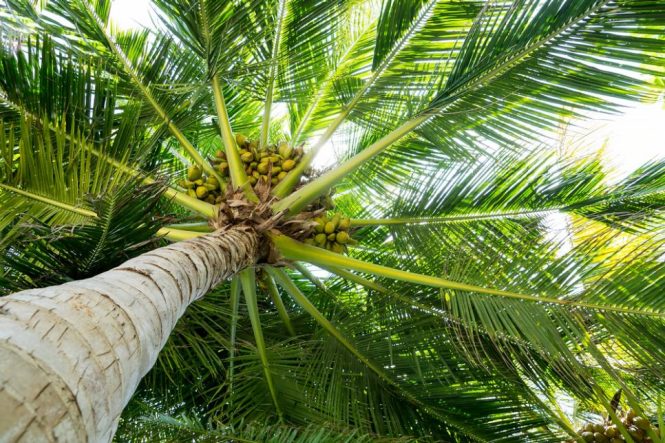
Learn about the fascinating world of palm trees, a diverse and fascinating group of trees in the Arecaceae family. The distinctive appearance of palm trees can be attributed to their slender trunks and crown of fan-shaped leaves, as well as their association with warm, tropical climates.
What is Palm Tree?
The palm tree is a tropical or subtropical tree belonging to the Arecaceae family. Long, slender trunks and a crown of sizable, fan-shaped or feather-like leaves at the top of the tree are features that set this species of trees apart. It is most common to find palm trees in tropical regions around the world, where they are associated with warm, sunny climates.
It is possible to find palm trees of different sizes, ranging from small shrubs to giants over a hundred feet high. As far as their shapes, leaf structures, and growth habits are concerned, they are all diverse. The coconut palm, the date palm, the oil palm, and the iconic royal palm are some of the more well-known species of palm trees.
There is a high value placed on palm trees for their aesthetic appeal and they are frequently planted in gardens, parks, and along streets to provide shade and an atmosphere of tropical comfort. Additionally, they contribute significantly to the economy through the production of various products, such as coconuts, palm oil, and palm fronds used in thatching and weaving.
Types of Palm Tree
There are many different types of palm trees, which are also described in terms of their characteristics and appearance
1. Coconut Palm
Characteristics and Appearance
This palm tree is known for its tall stature and feathery, arching fronds, making it one of the most recognizable palm trees. Despite its impressive height, this tree produces large, round coconuts that measure up to 100 feet in diameter. A smooth, gray trunk with a slight curve can be observed on the tree.
2. Date Palm
Characteristics and Appearance
The Date Palm (Phoenix dactylifera) is a magnificent tree that has a slender trunk and long, arching fronds that are adorned with sharp spines. There are several varieties of this palm, which can grow as high as 80 feet and have dense foliage on their crowns. Fruits from the Date Palm are available in various sizes and colors and grow in large clusters.
3. Fan Palm
Characteristics and Appearance
Livistona species are commonly known as Fan Palms because of their distinctive fan-shaped leaves that radiate from a central point. A palm tree of this type can reach a height of 50 feet and has a thin trunk covered in fibrous material. Glossy green leaves with deep segmentation give this plant a decorative and elegant appearance.
4. Areca Palm
Characteristics and Appearance
It is also known as the Butterfly Palm or Golden Cane Palm (Dypsis lutescens). There are feathery, arching fronds of green color on this plant. A slender, golden-yellow trunk is crowned with gracefully drooping leaves on the Areca Palm.
5. Royal Palm
Characteristics and Appearance
This majestic palm tree (Roystonea spp.) can reach heights of 80 feet or more and has a slender, smooth trunk. The leaves of this plant are large and pinnate, and they are feathery in appearance. This tree’s crown shaft, a smooth, green column at the top of the trunk, contributes to its regal and distinguished appearance.
6. Queen Palm
Characteristics and Appearance
A Queen Palm (Syagrus romanzoffiana) is a medium-sized palm tree with a slender trunk that can grow up to 50 feet in height—embraced by long, arching fronds that are pinnately divided and dark green. Old leaf scars are ringing the trunk of Queen Palm. The trunk is smooth, grayish-brown, and ringed with old leaves.
7. Canary Island Date Palm
Characteristics and Appearance
Phoenix canariensis, also known as the Canary Island Date Palm, is a large palm tree with a stout trunk that can reach impressive heights of 60 feet. This plant has large, pinnate leaves with a deep green color. A unique crisscross pattern is formed by remnants of old leaf bases on the trunk of the Canary Island Date Palm.
8. Sago Palm
Characteristics and Appearance
Even though Sago Palms (Cycas revoluta) are not real palm trees, they are often referred to as palms due to their resemblance to palm trees. This slow-growing cycad is covered in coarse, brown fibers and has a thick, rugged trunk. A dense crown forms at the top of the Sago Palm, which has stiff, feathery leaves that are deep green.
9. Bismarck Palm
Characteristics and Appearance
Bismarck Palms (Bismarckia nobilis) are distinctive palm trees with stout trunks coated in silver-gray, waxy material. Typically, it reaches heights of more than 60 feet and has huge, fan-shaped leaves that are bluish-green. Any landscape will be enhanced by the distinctive foliage and robust structure of the Bismarck Palm.
Conclusion
Palm trees are not only a symbol of tropical beauty, but they also provide us with several health benefits. We continue to be fascinated and captivated by palm trees because of their aesthetic appeal and practical applications in various industries. Understanding their characteristics, cultivating them with care, and appreciating their unique qualities will enable us to create breathtaking landscapes and enjoy the natural splendor they provide.